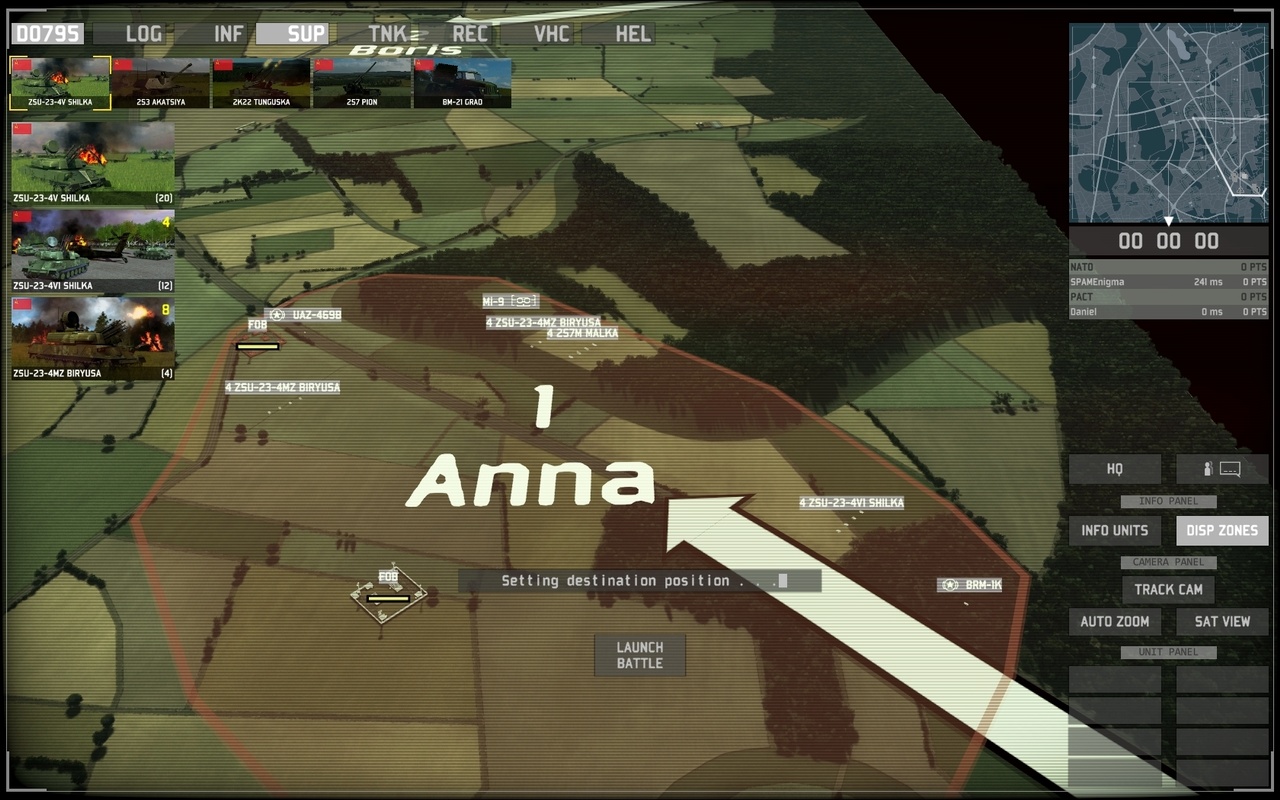If the best wargames and best real-time strategy games were selectively bred over several generations, the result would be Wargame: European Escalation, an "easy to learn yet difficult to master" wargame that plays out in real time. Set during the twilight years of the Cold War, Wargame boasts an epic campaign and crafty AI. In addition, it lets you zoom out the camera far beyond the normal confines of RTS games, giving you a view of the battlefield matched only by the likes of Supreme Commander or Sins of a Solar Empire. Eugen Systems has managed to craft both a great wargame and an entertaining RTS in one exhilarating package.
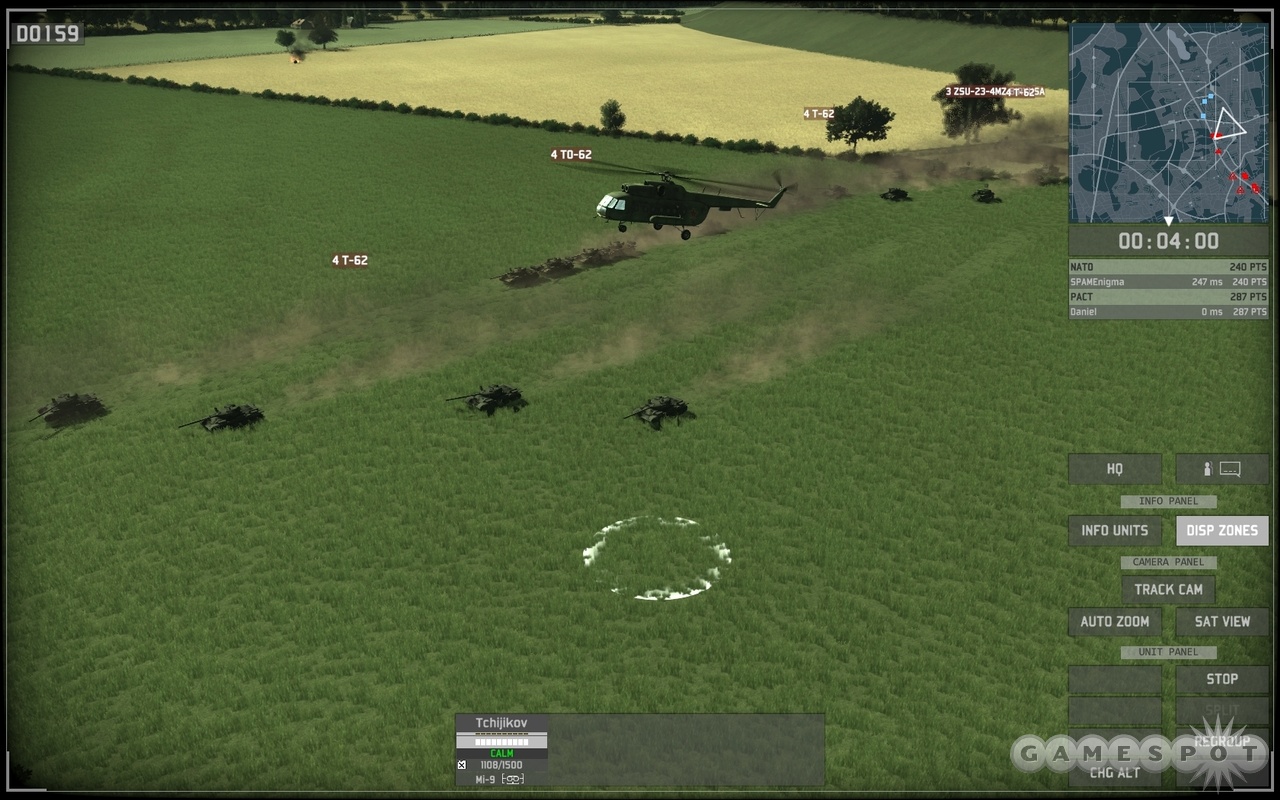
Wargame: European Escalation is well named because it feels more like a Panzer General-style "beer and pretzels" wargame than a real-time strategy game. There is no base building or unit micromanagement, but you have more traditional wargame concerns to focus on instead. For example, units have a finite amount of ammunition and fuel and must be resupplied in the field. Supply trucks can repair, rearm, and refuel units, but they also have a finite number of supplies. To keep an offense rolling, your best bet is to use the FOBs to restock the supply trucks and send them scurrying back to the front. Another example of Wargame's rich heritage is the role that terrain plays in the game. For instance, most units have trouble seeing over the next hill or spotting threats hidden in a nearby dense forest.
Therefore, sensible use of reconnaissance units is important. Furthermore, vehicles can get temporarily bogged down in harsh terrain like swamps. Roads are important because they allow for quicker movement and better fuel efficiency, but they can be death traps for your armored column if they run past dense woods packed with enemy antitank infantry. Blitzing through open countryside may seem like a convenient way to avoid certain obstacles, but helicopters more than 2,000 meters away may see your forces and open up on them with rocket pods and antitank guided missiles.
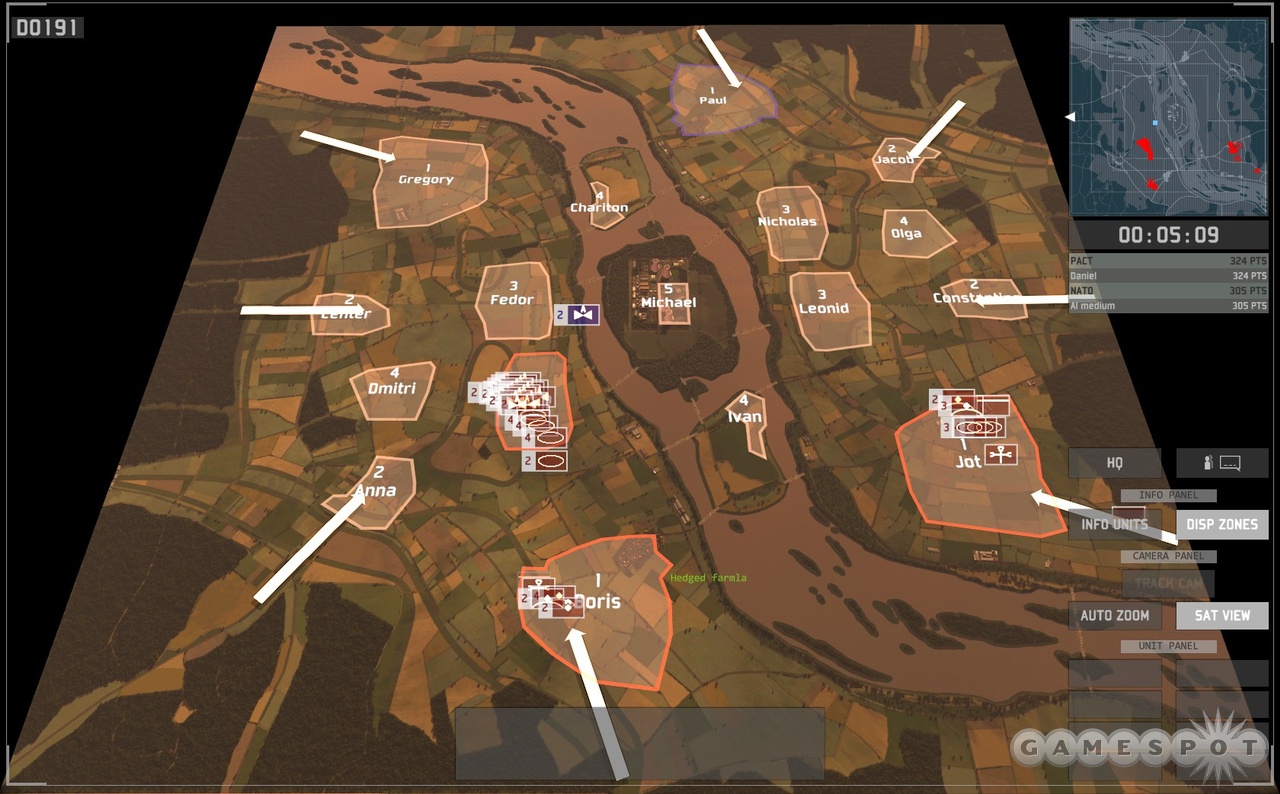
The wargame heritage doesn't stop there. Each of the game's hundreds of units has unique stats. For example, the AMX-30B2 tank has three types of weapon systems, each of which has different stats like caliber, range, ammo, rate of fire, accuracy, and armor-piercing-versus-high-explosive attack values. Besides the weapons, units have stats like speed, fuel capacity, optics, and armor (and front, side, rear, and top armor have separate values). Furthermore, units have morale, and if their morale drops too low, they become too panicked to respond to your orders. Retreating units need precious minutes to regain their composure, which can be disastrous for the unit in question, as well as your plans.
By contrast, the RTS side of Wargame's heritage is fairly minimal. There are no bases to build, no special powers or superweapons to use, and resourcing is limited to securing zones on the map with a command vehicle. New units may be requisitioned with the points that trickle in from the zones you occupy, provided that you control a deployment zone (the areas on the edges of the map marked with large white arrows).
Also, there is very little in the way of unit micromanagement. Your control options are as follows: you can toggle certain weapon systems on or off, regroup four straggling tanks into a platoon, order units to fire at an area they cannot see (particularly useful for having artillery demoralize anyone in the general vicinity of where their ordinance hits), command units to use roads whenever possible, tell helicopters to change their altitudes, or move infantry units into and out of transport vehicles.

At first glance, Wargame is a daunting prospect. There are a lot of variables to consider, and it does play out in real time, after all. However, a smart interface makes it very approachable. First off, Wargame allows you a better view of the battlefield than most RTS games, which tend to prevent you from zooming too far above your units.
In Wargame, you can zoom out to a bird's-eye view reminiscent of Supreme Commander, at which point all the units turn into their respective standard NATO military symbols. Icons appear over units when they are running low on fuel or ammo or when they are in danger of being routed. If you pull the camera in closer, red text above the unit informs you of various problems and how long these effects will persist. For example, a shot-up helicopter may have the message "fuel leak 20 seconds" above it, or a tank may be cursed by "damaged tracks 5 seconds."
It's a useful way to tell why your units are not behaving as you want them to and how long you need to wait before everything is back in proper order. Selecting a unit quickly tells you its current morale, ammo, fuel, and damage. Little circles above the units slowly form, detailing when a unit will finish reloading its main gun and be able to fire it again. Furthermore, you can toggle an in-game information panel that lets you see a specific unit type's stats. The interface makes Wargame more approachable for everyone while giving those interested easy access to more detailed statistics.
Wargame contains four separate single-player campaigns. Each campaign, except for the fourth one, is self-contained and based on a historical event that could have spiraled out of control. The first campaign begins when East German soldier Werner Weinhold kills two of his comrades while escaping to West Germany. The second starts when General Jaruzelski takes control of the Polish Communist Party and declares martial law (in part to forestall Warsaw Pact military intervention in Poland). The third centers on NATO's Able Archer military exercise.
However, in each of these scenarios, history takes a violent turn: the East Germans invade West Germany after it refuses to extradite Weinhold, the bulk of the Polish military refuses to stand behind Jaruzelski and spearheads a national uprising against Communist rule, and the Warsaw Pact mistakes Able Archer as a prelude to a NATO attack and launches a preemptive offensive against Western Europe. The campaigns are all set during a specific time frame, limiting your unit selection to vehicles that were available during that period (including the West German-US jointly designed MBT-70 tank, which for budgetary reasons never got past the prototype stage).
The campaigns sport 22 missions in total and could easily take 20 to 30 hours to complete, especially if you replay missions to achieve secondary objectives. Accomplishing mission objectives gives you command stars that you can use to purchase new units for both single- and multiplayer games. Often you face a tough choice between purchasing a new unit that is usable in your current campaign and saving those points to purchase units for the later campaigns or multiplayer. Whichever route you go, you want to keep the units you do have alive, because they gain experience over the course of a campaign. Generally speaking, it's much better to have a handful of veteran T-80s than a couple dozen green T-62s.
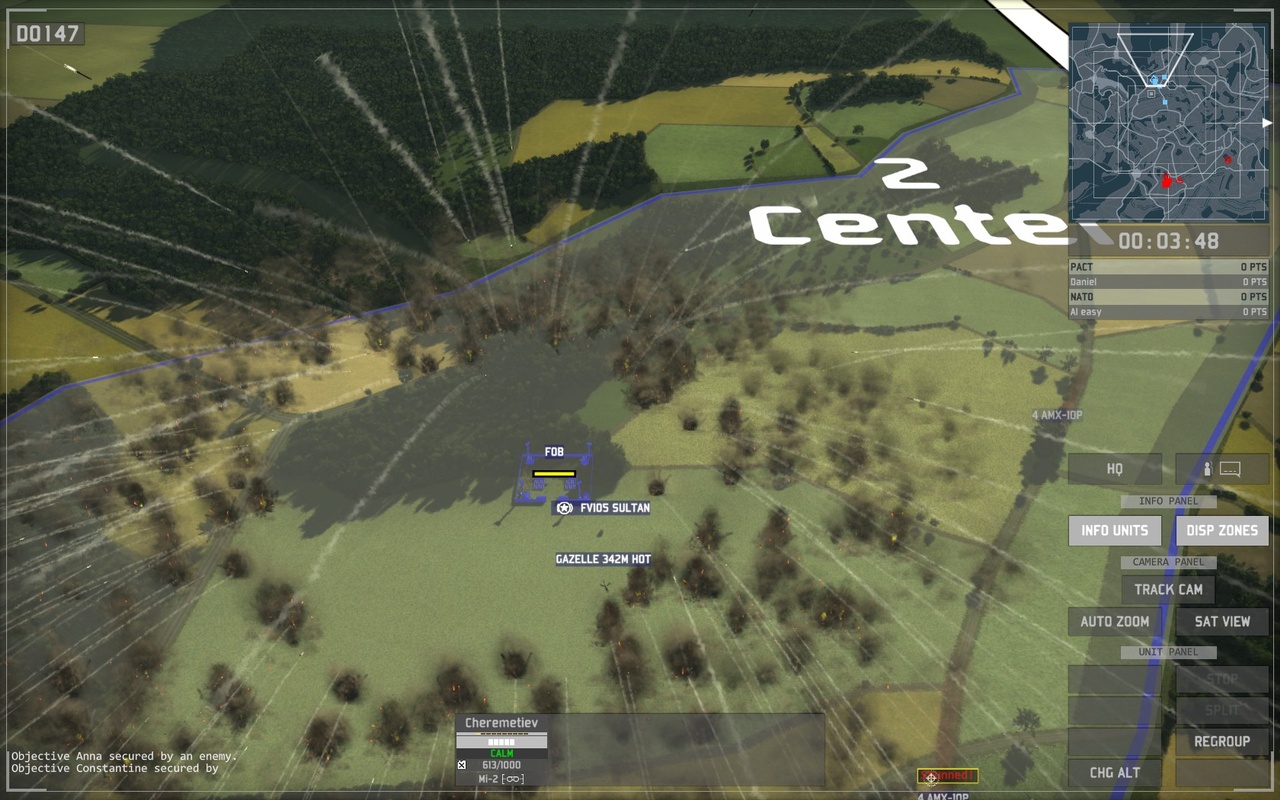
The missions are fairly varied with only a few "wipe out every enemy unit" or "hold point X for a certain amount of time" missions (though to be fair, some of those are quite good). For example, in one Soviet mission you have to break through Polish lines to save encircled Polish forces still loyal to the Warsaw Pact. In another Soviet mission, you have to hold off NATO troops while evacuating as many units as you can to escape an attempt to encircle your army. One of the most memorable missions is an American one that starts you behind enemy lines, low on fuel and ammo. You must capture enemy supply trucks and FOBs while trying to escape the combat zone (and, if you are lucky, meet up with other NATO units left behind and destroy pesky Soviet artillery during your jaunt home for some extra command stars).
One minor problem with all of the campaigns is that while most of them open with video footage of the events that started the campaign, none of them have an ending video. Of course it would be hard to find footage of events that never happened, but surely it would be easy to find footage of Soviet and American leaders meeting to represent a peace treaty being negotiated, or footage of a parade in Red Square to showcase a celebration of a Warsaw Pact victory. Still, this is a minor quibble, and the absence of ending cutscenes doesn't detract from the quality of the campaigns.
After you've played the first single-player campaign, which doubles as Wargame's tutorial, there are multiplayer and skirmish options available. In these modes you can field decks of unit cards earned with command stars gained through the single- and multiplayer modes. Each deck is limited to 25 units, but when adding a unit to a deck you also receive all of its variants that you've unlocked. So while a Leopard 1A1 would take up only one spot in your deck, the 1A2, 1A3, 1A4, and 1A5 would also be available. You are limited to five units per category (logistic, reconnaissance, tank, infantry, support, vehicle, and helicopter), so you have to pick wisely.

Multiplayer and skirmish modes are essentially identical, with the main difference being whether or not a computer player is involved. In both modes there are 11 maps, three team options (NATO vs. Warsaw Pact or intra-alliance conflicts), two victory conditions (time limit or destruction), and a choice of how many points' worth of units each player may start with. The skirmish AI is fairly crafty, much like the AI in Eugen's earlier Act of War series. Even the easy AI makes a valiant effort to find and destroy your precious command vehicles.
It's really a shame there are no options for a multiplayer "comp stomp" at this time. One difference between multiplayer and skirmish games is that multiplayer games, whether ranked or unranked, net you experience points. Once you get enough experience, you level up and gain extra command stars to spend on your decks.
The 11 maps suffer from a lack of diversity. There are no maps with large urban areas, for example. Instead, most maps are large rural areas with some hills, forests, and flatlands to traverse. The best of these is Hell's Highway, which includes a major highway running through the center of the map. Generally, the maps with rivers are more interesting because they break up the monotony somewhat. One example is the Three Mile Island map that is split by a gigantic river and includes three islands as well as a large center area to fight over. One of the islands even has a lovely nuclear plant on it, at least until you make it explode.
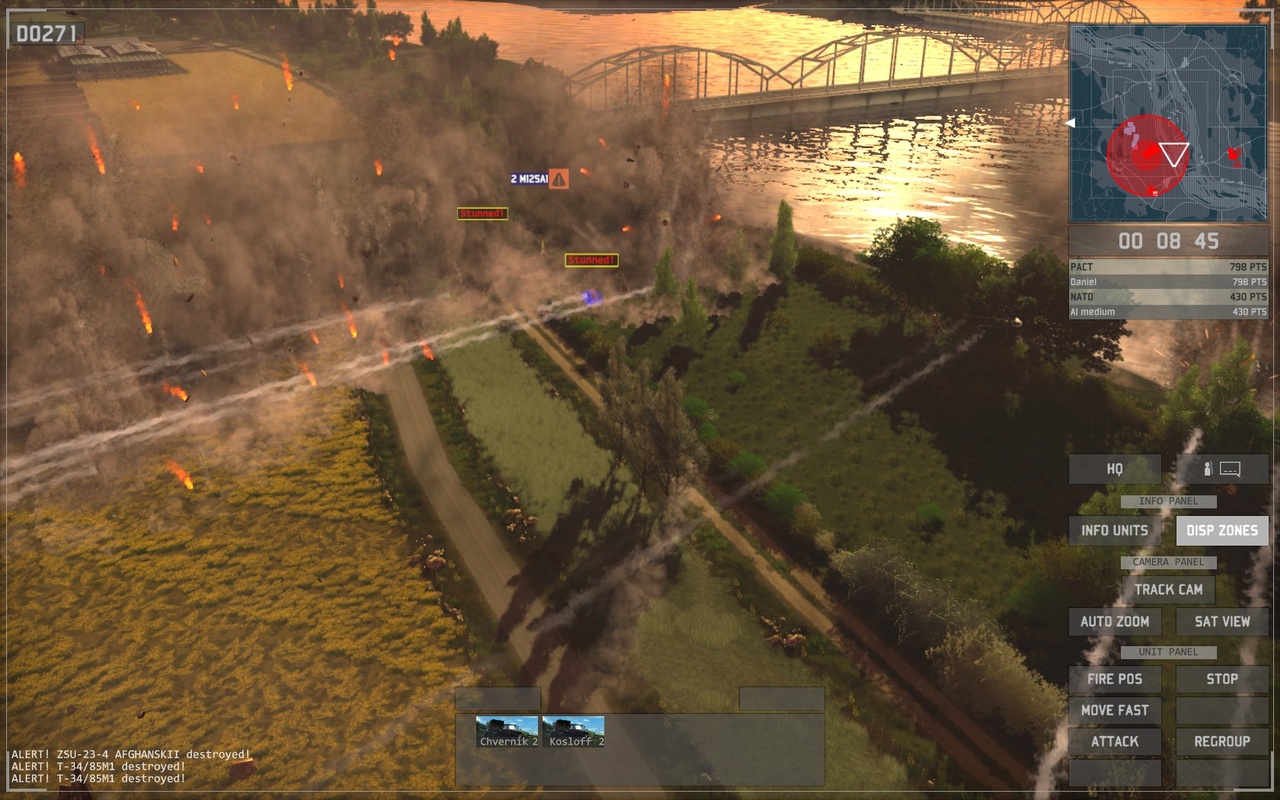
The best way to win in multiplayer or skirmish is to take out the enemy's command vehicles, since these are essential for locking down sectors and gaining resources. If you deny the enemy access to deployment zones, then they won't be getting any reinforcements, and if you destroy all of an enemy's command vehicles, it's an automatic victory. So be certain to keep yours hidden and well guarded. Even the easy AI loves to send helicopters out to hunt for your precious command vehicles.
Wargame’s visual and audio design is exceptional. When you are zoomed in, the vehicle models look very detailed. The only details missing are minor things like fields rustling beneath a hovering helicopter. Overall, the vehicles look accurate and blow up nicely. Unfortunately, you are probably going to be playing from a zoomed-out perspective and will miss out on much of the detail. The sound effects are great, but the music is entirely forgettable. The unit chatter is somewhat disappointing despite being in the national language of the selected force.
Unfortunately, units repeat the same lines and don't seem to react to the events in the world around them. It would be much cooler to hear the crew of a Challenger 1 yell about being attacked by T-34s than listen to them repeat "Lead, follow, or get out of the way" whenever they are clicked on. The only dialogue that seems to be contextual occurs when your helicopter pilots hum Wagner's Ride of the Valkyries as they blow up a ton of units.
The other issues with the sound are minor: occasionally the voice-overs detailing mission objectives are slightly different from the onscreen text (though the gist of what they are saying is always the same), and the voice acting of the main character in the fourth campaign is laughably emotionless given that campaign's plot.
Wargame: European Escalation, despite its few flaws, is something special. It's an accessible wargame/RTS hybrid with the capability to engross both fans of the good old-fashioned tank rush and hardcore grognards (who have been debating which side would win in a non-nuclear Third World War for decades). The genres merge well, the graphics and interface are great, and the single-player campaigns alone offer an immense value. Most importantly, it answers some of life's most important questions, like how many T-34/85s a platoon of Challenger 1s can take down before they are finally overwhelmed.
